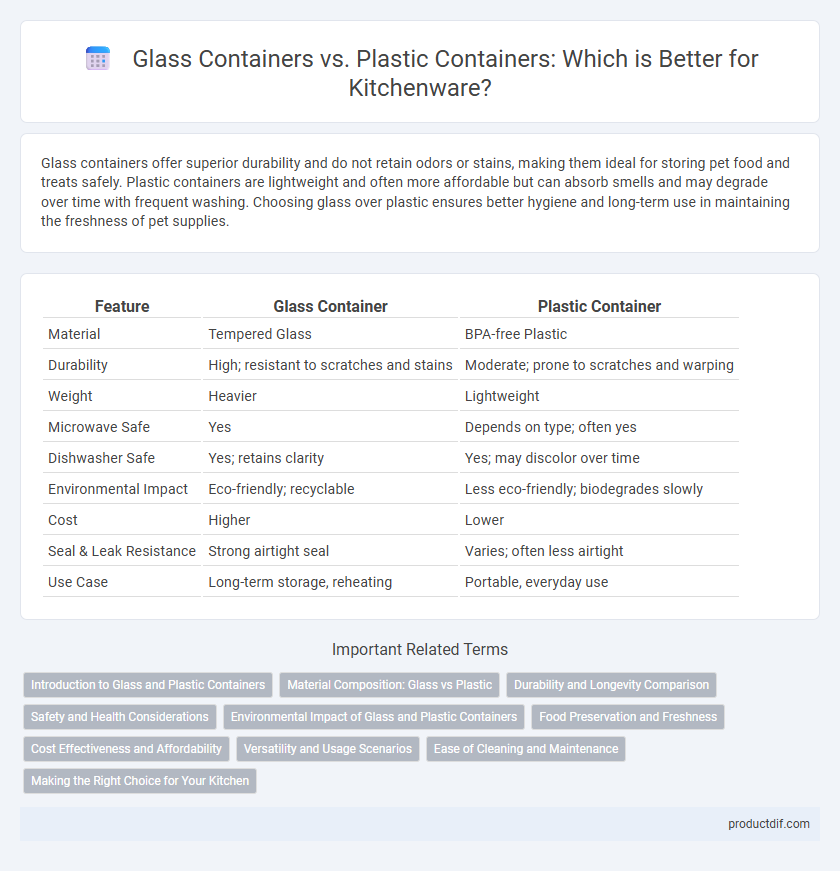Glass containers offer superior durability and do not retain odors or stains, making them ideal for storing pet food and treats safely. Plastic containers are lightweight and often more affordable but can absorb smells and may degrade over time with frequent washing. Choosing glass over plastic ensures better hygiene and long-term use in maintaining the freshness of pet supplies.
Table of Comparison
| Feature | Glass Container | Plastic Container |
|---|---|---|
| Material | Tempered Glass | BPA-free Plastic |
| Durability | High; resistant to scratches and stains | Moderate; prone to scratches and warping |
| Weight | Heavier | Lightweight |
| Microwave Safe | Yes | Depends on type; often yes |
| Dishwasher Safe | Yes; retains clarity | Yes; may discolor over time |
| Environmental Impact | Eco-friendly; recyclable | Less eco-friendly; biodegrades slowly |
| Cost | Higher | Lower |
| Seal & Leak Resistance | Strong airtight seal | Varies; often less airtight |
| Use Case | Long-term storage, reheating | Portable, everyday use |
Introduction to Glass and Plastic Containers
Glass containers offer non-porous, BPA-free storage that preserves food flavor and resists stains and odors, making them ideal for long-term food preservation. Plastic containers provide lightweight, shatter-resistant options available in various sizes and shapes, often featuring airtight seals to prevent leaks. Both types serve essential roles in kitchenware, with glass favored for durability and safety, while plastic offers convenience and portability.
Material Composition: Glass vs Plastic
Glass containers are made from silica-based materials, offering non-porous, inert surfaces that resist staining and odor retention, making them ideal for food storage and microwave use. Plastic containers are composed of polymers like polyethylene or polypropylene, which are lightweight and impact-resistant but may leach chemicals over time, especially when exposed to heat. The material composition significantly affects durability, safety, and environmental impact, with glass providing a more sustainable and health-conscious option compared to most plastics.
Durability and Longevity Comparison
Glass containers offer superior durability and longevity compared to plastic containers due to their resistance to scratches, stains, and odor retention. They maintain structural integrity over time without warping or degrading, making them ideal for long-term storage and repeated use. Plastic containers are more prone to cracking, discoloration, and absorbing smells, which can reduce their usability and lifespan.
Safety and Health Considerations
Glass containers are non-toxic, BPA-free, and do not leach harmful chemicals into food, making them a safer choice for long-term storage and reheating. Plastic containers may contain phthalates or BPA, which can pose health risks, particularly when heated or scratched. Choosing glass reduces exposure to potential carcinogens and endocrine disruptors commonly found in some plastics.
Environmental Impact of Glass and Plastic Containers
Glass containers have a significantly lower environmental impact due to their recyclability and longer lifespan compared to plastic containers, which often end up in landfills and oceans contributing to pollution. The production of plastic containers relies heavily on fossil fuels, releasing greenhouse gases, while glass production also has emissions but benefits from being infinitely recyclable without quality loss. Choosing glass reduces microplastic contamination and supports sustainable waste management practices in kitchenware usage.
Food Preservation and Freshness
Glass containers offer superior food preservation by providing an airtight seal that prevents moisture and oxygen from compromising freshness, making them ideal for long-term storage. Plastic containers, while lightweight and flexible, often allow slight air permeability that can diminish food quality over time. For optimal freshness retention, glass containers are preferred due to their non-porous surface and resistance to staining and odors.
Cost Effectiveness and Affordability
Glass containers typically have higher upfront costs than plastic containers but offer greater durability and long-term value due to their resistance to stains, odors, and scratches. Plastic containers are more affordable initially, making them a budget-friendly option for short-term use, but they may need frequent replacement due to wear and potential chemical leaching over time. Considering cost effectiveness, investing in glass containers often results in savings over time by reducing the need for frequent replacements and maintaining food quality longer.
Versatility and Usage Scenarios
Glass containers excel in versatility due to their heat resistance, making them suitable for oven, microwave, and freezer use, as well as for storing acidic foods without leaching chemicals. Plastic containers offer lightweight convenience and are ideal for quick storage, transport, and non-heated food items but may degrade with prolonged heat exposure or acidic content. Choosing between glass and plastic hinges on specific usage scenarios such as durability, temperature tolerance, and food safety requirements.
Ease of Cleaning and Maintenance
Glass containers offer superior ease of cleaning due to their non-porous surfaces, which resist stains and odors better than plastic containers. They can be safely washed at high temperatures in dishwashers without degrading or warping, ensuring long-lasting clarity and hygiene. Plastic containers often retain residues and develop scratches that harbor bacteria, making maintenance more time-consuming and less effective over time.
Making the Right Choice for Your Kitchen
Glass containers offer superior durability and do not leach chemicals into food, making them a safer choice for storing meals and ingredients. Plastic containers are lightweight and typically more affordable, but they may absorb odors and stains and can degrade over time due to exposure to heat and microwaves. When selecting kitchenware, prioritize glass containers for long-term food safety and plastic containers for convenience and portability.
Glass container vs Plastic container Infographic

 productdif.com
productdif.com